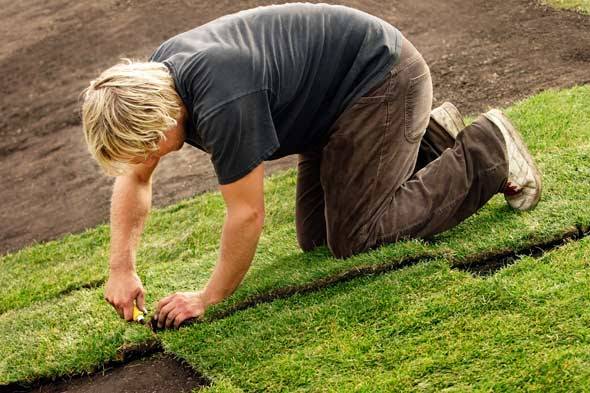






A lawn is one of the most important features in a garden. It provides an important refreshing green foil for colorful flowering plants and a place for the family to relax and play. However, in order for it to be a success, much careful thought and preparation are necessary during its establishment.
The usual methods of making a new lawn are by sowing seed or laying sod. A lawn can be created from seed in either early fall or spring. As it takes time to prepare the seed bed work should commence well beforehand. The soil for a lawn raised from seed must be firm and settled. If the area has been recently deeply cultivated, then this can take some weeks to occur naturally. Settlement through rain and the passage of time is preferable to artificial compaction with the feet or a heavy roller.
With all lawns drainage is important and this should be in place before work commences. The soil should be well cultivated and free from all perennial weeds as in the short term these will be very difficult to eliminate. Annual weed seedlings are not such a problem and are easily cut out by the first passes across the lawn with the lawnmower.
Rake the soil out so that it is even. It need not be level, but the surface, if it is sloping, should be in an even plane. An uneven surface will cause difficulties for the lawnmower. Once raked out the soil should be firmed but not compacted. While commercially there are machines that will do this job, the best method for the home gardener is to shuffle from side to side across the intended lawn area with the feet. Following this, rake out any uneven areas and then lightly rake the whole surface. The lawn is then ready for sowing.
Choose a seed mixture to suit circumstances. One with rye grass for a hard wearing lawn, one without for a decorative lawn. If the site is shady, then select a shade mixture and always be sure any grass seed is treated with bird repellent. Instructions will be provided as to the rate to sow according to the mixture of grasses it contains.
Roughly mark out the area in square yards, using the end of a stick or a bamboo cane run gently through the soil. Choose a container that will hold the quantity of seed required for each square yard and even distribution will be simple. Keep well watered until well established.
Although creating a lawn from sod is a little more expensive than from seed it can be used by the family a lot sooner.
If laid during spring it can be used throughout the following summer. A seed raised lawn sown during the spring is unlikely to be capable of sustaining foot traffic until late summer or early fall. A fall laid lawn established from sod should be ready for use the following spring.
Soil preparations are much the same for sod as they are for seed. The key is a friable, well firmed soil free from perennial weeds. It should have been allowed to settle naturally and then shuffled across with the feet to firm the surface before raking level. It is useful both for leveling and to aid the rooting of the sod to spread a thin layer of sand over the prepared lawn area to take out any slight unevenness.
There are various different grades of sod, but meadow sod should generally be avoided. Rarely is it a wise purchase. Traditional meadow sod is exactly as described, rarely weed-free and often containing undesirable grass species. Not only does it produce a mediocre lawn but unless very carefully managed will spread grass weed seeds into surrounding beds and borders.
Cultivated sod will cost a little more but it is a worthwhile investment. If the lawn is for the family to enjoy and to play on, then a sod raised from a seed containing rye grass is ideal. If it is merely a decorative feature, choose one comprising a mixture of finer grasses. Sod growing is now an extensive and very professional industry, so if there are any doubts about the most suitable mixture to select, do not hesitate to contact a local sod grower for advice.
Sod is lifted in strips and rolled up for transportation. Unroll and lay it as soon as it is received. Remember it is a living product and subject to rapid deterioration if not handled promptly. It is laid on the ground like a carpet, the edges being tightly abutted to one another. Lay the strips on the same principle as bricks in a wall, with the joints arranged alternatively. Firm the laid sod down gently and brush sharp sand into any cracks. Water freely until it has become well established. If watering is neglected the strips will shrink and the lawn will be ruined.
Article by Philip Swindells. Philip has over 40 years gardening experience. A former botanical garden curator and an international horticultural consultant, he has worked extensively overseas. The Author of more than 50 gardening books, he has been awarded a Quill and Trowel Award by the Garden Writers’ Association of America. He is also a former UK Garden Writer of the Year. He writes a popular daily gardening blog with gardening news, views and updates http://www.gardenmessenger.blogspot.com/
Copyright © www.100flowers.win Botanic Garden All Rights Reserved